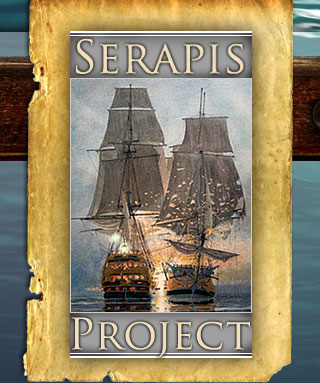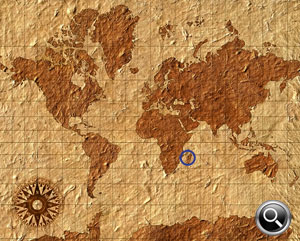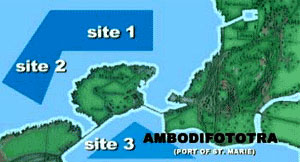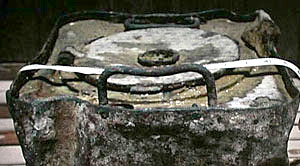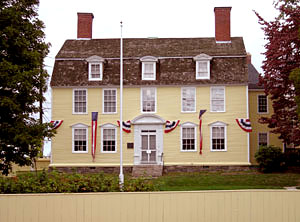The Expedition:
Richard "Dick" Swete's goal was to find, and preserve, all of John Paul Jones' ships. A historian and underwater archaeologist, he spent years researching Jones and the American Revolutionary naval battle between the HMS Serapis and the HMS Bon Homme Richard. Gathering a group of volunteers, his own modest income and a great deal of perseverance, Swete laid plans to find Serapis.
Fact Finding
Fairly certain of where to search for the Serapis off the Isle Sainte Marie, Madagascar, Swete first traveled to the area in January 1999. Swete decided to personally fund the project until he discovered and secured the shipwreck. His goal was to minimize publicity to protect the wreck and recruit professionals to survey, conserve and display cultural resources.
While in Antananarivo, the capital of Madagascar, Swete visited government officials, the U.S. embassy, explored archives and the local museum. He then spent several weeks on Isle Sainte Marie diving on possible targets, and spoke with locals about the establishment of a museum that would house cataloged Serapis artifacts and exhibits on local maritime traditions.
"I hold no illusions that she (Serapis) will be found on this trip, but she is here," said Swete. Serapis was not found on the first trip, but a great deal of groundwork was laid.
In later 1999, Swete returned to Madagascar with his wife, Sharon. Attending "whale season" festivities and further developing vital relationships with local officials, he worked to understand the culture and to convey to the locals the importance of preserving their underwater resources.
An Academic Home in Portsmouth, New Hampshire
Swete believed that an educational bridge between Madagascar and the United States was vital to the Serapis Project. A natural connection to Portsmouth, New Hampshire materialized when Swete learned that John Paul Jones' lived in Portsmouth while supervising the construction of the U.S. Ranger for the navy. The home where John Paul Jones lived is still standing today. This finding was highlighted by the fact that Swete's friend and mentor, Dr. Dave Switzer, was New Hampshire's state archaeologist.
This Portsmouth connection led to the Serapis Project's academic home and non-profit status for the Serapis Project under the academic umbrella under the Institute of New Hampshire Studies of Plymouth State University. Swete's relationship with the Institute de Civilisations/Musee d'art et d'Archeology and the University of Antananarivo in Madagascar further enhanced project viability by teaming up with local archaeologists and students.
Third Time's A Charm
On November 18, 1999, Swete made his third journey to Madagascar. With a proficient team in place, they began surveying potential sites with the magnetometer and taking GPS navigation points. As the island's geology is composed of a great deal of iron, the ferrous conditions caused the magnetometer to react erratically. Despite the geological smoke, the team found three primary targets to dive. Target one yielded a 90-foot shot of anchor chain strung out along the bottom. Then, on the second dive, after 218 years, the Serapis was found! Although she was covered in sand and silt, the team discovered part of her copper sheathing, a key, some wood and a copper box.
The Team Comes Together
In October 2000, Swete led an international team on an expedition to Madagascar. The primary goals were to train Malagasy students to be archaeological divers; define the perimeter of the site; and set the scene for a conservation laboratory and subsequent museum exhibits.
The Expedition Takes A Tragic Turn
Tragically, after only a few dives, the untimely death of Richard Swete gave way to unforeseen challenges and the delay of the Serapis Project. While directing the Serapis site investigation, Dick Swete succumbed to an acute attack of malaria. The project had to be reinvented without Swete and new relationships needed to be forged with the government of Madagascar before the Serapis Project could continue
A New Day
In May 2004, a team of archaeologists and historians led by Michael Tuttle and Dr. Jean Aime Rakotoarisoa embarked on the next phase of the Serapis Project and the continuation of Richard Swete's life work. The stories of John Paul Jones, the HMS Serapis, the HMS Bon Homme Richard and the Serapis Project continue to come to life as the next chapter unfolds.
The Documentary
Documentary Filmmaker Prichard Smith first began work on the Serapis Project using footage from Swete's first two visits to Madagascar. The idea was to create a promotional film to assist Swete in his fundraising efforts.
After Swete's death, Smith began an innovative filmmaking effort to create public interest and support for the project's completion. The result is an ongoing documentary that details Swete's career and his efforts with the H.M.S. Serapis.
Supported entirely by Smith's personal funds and modest private donations, this "work-in-progress" won Best Documentary Film at the Indie Memphis Film Festival 2001.
Introduction to the Film
Dr. Warren Riess - re. Dick Swete
Identifying the Artifacts - Copper Found
Mike Tuttle - 2000 Expedition
